The Response of Vegetation Dynamics to Climate in Xinjiang from 1991 to 2018
Abstract
1. Introduction
2. Materials and Methods
2.1. Study Area
2.2. Data Sources and Preprocessing
2.2.1. Meteorological Data
2.2.2. Vegetation Data
2.2.3. Land Use Data
2.3. Method
2.3.1. Trend Analysis
2.3.2. Land Use Transfer Matrix
2.3.3. Correlation Analysis
3. Results
3.1. Temporal and Spatial Variations of Vegetation Characteristics
3.1.1. NDVI Change Trend
3.1.2. LAI Change Trend
3.1.3. GPP Change Trend
3.2. Temporal and Spatial Variations of Vegetation Types and Areas
3.3. The Response of Vegetation to Climate Change
3.3.1. The Changing Trend of Climate Factors
3.3.2. The Correlation Between Vegetation and Precipitation
3.3.3. The Correlation Between Vegetation and Temperature
4. Discussion
5. Conclusions
Supplementary Materials
Author Contributions
Funding
Data Availability Statement
Conflicts of Interest
References
- Gong, G.; Liu, J.; Shao, Q.; Zhai, J. Sand-fixing Function under the Change of Vegetation Coverage in a Wind Erosion Area in Northern China. J. Resour. Ecol. 2014, 5, 105–114. [Google Scholar] [CrossRef]
- Hanusová, H.; Juřenová, K.; Hurajová, E.; Vaverková, M.; Winkler, J. Vegetation structure of bio-belts as agro-environmentally-climatic measures to support biodiversity on arable land: A case study. AIMS Agric. Food 2022, 7, 883–896. [Google Scholar] [CrossRef]
- Zhang, X.; Li, X.; Nian, L.; Samuel, A.; Liu, X.; Liu, X.; Hui, C.; Zhang, M. Topographic and Climatic Factors Effect Spatiotemporal Coupling Relationship of Soil Water Conservation Function with Vegetation in Source of the Yellow River. Sustainability 2024, 16, 6039. [Google Scholar] [CrossRef]
- Artini, G.; Francalanci, S.; Solari, L.; Aberle, J. Effects of leafy flexible vegetation on bed-load transport and dune geometry. Water Resour. Res. 2024, 60, e2023WR036588. [Google Scholar] [CrossRef]
- Wang, Y.; Fu, B.; Liu, Y.; Li, Y.; Feng, X.; Wang, S. Response of vegetation to drought in the Tibetan Plateau: Elevation differentiation and the dominant factors. Agric. For. Meteorol. 2021, 306, 108468. [Google Scholar] [CrossRef]
- Zhang, Q.; Yang, J.; Wang, W.; Ma, P.; Lu, G.; Liu, X.; Yu, H.; Fang, F. Climatic warming and humidification in the arid region of Northwest China: Multi-scale characteristics and impacts on ecological vegetation. J. Meteor. Res. 2021, 35, 113–127. [Google Scholar] [CrossRef]
- Jiang, H.; Xu, X.; Zhang, T.; Xia, H.; Huang, Y.; Qiao, S. The Relative Roles of Climate Variation and Human Activities in Vegetation Dynamics in Coastal China from 2000 to 2019. Remote Sens. 2022, 14, 2485. [Google Scholar] [CrossRef]
- Gao, X.; Zhuo, W.; Gonsamo, A. Humid, warm and treed ecosystems show longer time-lag of vegetation response to climate. Geophys. Res. Lett. 2024, 51, e2024GL111737. [Google Scholar] [CrossRef]
- Liu, Y.; Zhang, X.; Du, X.; Du, Z.; Sun, M. Alpine grassland greening on the Northern Tibetan Plateau driven by climate change and human activities considering extreme temperature and soil moisture. Sci. Total Environ. 2024, 916, 169995. [Google Scholar] [CrossRef]
- Ma, Q.; Hänninen, H.; Berninger, F.; Li, X.; Huang, J. Climate warming leads to advanced fruit development period of temperate woody species but divergent changes in its length. Glob. Change Biol. 2022, 28, 6021–6032. [Google Scholar] [CrossRef]
- Ma, Z.; Peng, C.; Zhu, Q.; Chen, H.; Yu, G.; Li, W.; Zhou, X.; Wang, W.; Zhang, W. Regional drought-induced reduction in the biomass carbon sink of Canada’s boreal forests. Proc. Natl. Acad. Sci. USA 2012, 109, 2423–2427. [Google Scholar] [CrossRef]
- Ge, W.; Deng, L.; Wang, F.; Han, J. Quantifying the contributions of human activities and climate change to vegetation net primary productivity dynamics in China from 2001 to 2016. Sci. Total Environ. 2021, 773, 145648. [Google Scholar] [CrossRef] [PubMed]
- Gao, B.; Liu, E.; Yang, Y.; Yang, M.; Yao, Y.; Guan, L.; Feng, Y. Quantitative contributions of climate change and human activities to vegetation dynamics in the Zoige Plateau from 2001 to 2020. J. Mt. Sci. 2024, 21, 3031–3046. [Google Scholar] [CrossRef]
- Wang, B.; Chen, W.; Tian, D.; Li, Z.; Wang, J.; Fu, Z.; Luo, Y.; Piao, S.; Yu, G.; Niu, S. Dryness limits vegetation pace to cope with temperature change in warm regions. Glob. Chang. Biol. 2023, 29, 4750–4757. [Google Scholar] [CrossRef] [PubMed]
- Yang, Y.; Wang, X.; Wang, T. Permafrost degradation induces the abrupt changes of vegetation NDVI in the Northern Hemisphere. Earth’s Future 2024, 12, e2023EF004309. [Google Scholar] [CrossRef]
- Zafarmomen, N.; Alizadeh, H.; Bayat, M.; Ehtiat, M.; Moradkhani, H. Assimilation of sentinel-based leaf area index for modeling surface-ground water interactions in irrigation districts. Water Resour. Res. 2024, 60, e2023WR036080. [Google Scholar] [CrossRef]
- Fu, B.; Yang, W.; Yao, H.; He, H.; Lan, G.; Gao, E.; Qin, J.; Fan, D.; Chen, Z. Evaluation of spatio-temporal variations of FVC and its relationship with climate change using GEE and Landsat images in Ganjiang River Basin. Geocarto Int. 2022, 37, 13658–13688. [Google Scholar] [CrossRef]
- Gu, Y.; Pang, B.; Qiao, X.; Xu, D.; Li, W.; Yan, Y.; Dou, H.; Ao, W.; Wang, W.; Zou, C.; et al. Vegetation dynamics in response to climate change and human activities in the Hulun Lake basin from 1981 to 2019. Ecol. Indic. 2022, 136, 108700. [Google Scholar] [CrossRef]
- Guo, R.; Cai, A.; Chen, X. The quantitative effects of climate change and human activity on the vegetation growth in the Yangtze River Basin. Front. Earth Sci. 2023, 11, 1168384. [Google Scholar] [CrossRef]
- da Silva, J.L.P.; da Silva Junior, F.B.; de Souza Santos, J.P.A.; dos Santos Almeida, A.C.; da Silva, T.G.F.; Oliveira-Júnior, J.F.d.; Araújo Júnior, G.d.N.; Scheibel, C.H.; da Silva, J.L.B.; de Lima, J.L.M.P.; et al. Semi-Arid to Arid Scenario Shift: Is the Cabrobó Desertification Nucleus Becoming Arid? Remote Sens. 2024, 16, 2834. [Google Scholar] [CrossRef]
- Piao, S.; Nan, H.; Huntingford, C.; Ciais, P.; Friedlingstein, P.; Sitch, S.; Peng, S.; Ahlström, A.; Canadell, J.; Cong, N.; et al. Evidence for a weakening relationship between interannual temperature variability and northern vegetation activity. Nat. commun. 2014, 5, 5018. [Google Scholar] [CrossRef] [PubMed]
- Shi, S.; Yu, J.; Wang, F.; Wang, P.; Zhang, Y.; Jin, K. Quantitative contributions of climate change and human activities to vegetation changes over multiple time scales on the Loess Plateau. Sci. Total Environ. 2021, 755, 142419. [Google Scholar] [CrossRef] [PubMed]
- Zhang, H.; Hu, Z.; Zhang, Z.; Li, Y.; Song, S.; Chen, X. How does vegetation change under the warm–wet tendency across Xinjiang, China? Int. J. Appl. Earth Obs. 2024, 127, 1569–8432. [Google Scholar] [CrossRef]
- Mekonnen, Z.; Grant, R.; Schwalm, C. Contrasting changes in gross primary productivity of different regions of North America as affected by warming in recent decades. Agric. Forest Meteorol. 2016, 218–219, 50–64. [Google Scholar] [CrossRef]
- Yan, J.; Zhang, G.; Deng, X.; Ling, H.; Xu, H.; Guo, B. Does Climate Change or Human Activity Lead to the Degradation in the Grassland Ecosystem in a Mountain-Basin System in an Arid Region of China? Sustainability 2019, 11, 2618. [Google Scholar] [CrossRef]
- Liu, H.; Wei, W.; Zhu, G.; Ding, Y.; Peng, X. The different vegetation types responses to potential evapotranspiration and precipitation in China. Front. Environ. Sci. 2024, 12, 1406621. [Google Scholar] [CrossRef]
- Lu, Q.; Kang, H.; Zhang, F.; Xia, Y.; Yan, B. Impact of climate and human activity on NDVI of different vegetation types in the Three-River Source Region, China. J. Arid Land 2024, 16, 1080–1097. [Google Scholar] [CrossRef]
- Zhang, X.; Xu, X.; Li, X.; Cui, P.; Zheng, D. A new scheme of climate-vegetation regionalization in the Hengduan Mountains Region. Sci. China-Earth Sci. 2024, 67, 751–768. [Google Scholar] [CrossRef]
- Shi, Y.; Shen, Y.; Li, D.; Zhang, G.; Ding, Y.; Hu, R.; Kang, E. Discussion on the present climate change from warm-dry to warm-wet in northwest China. Quatern. Sci. 2003, 23, 152–164. (In Chinese) [Google Scholar]
- Zhang, Q.; Yang, J.; Duan, X.; Ma, P.; Lu, G.; Zhu, B.; Liu, X.; Yue, P.; Wang, Y.; Liu, W. The eastward expansion of the climate humidification trend in northwest China and the synergistic influences on the circulation mechanism. Clim. Dyn. 2022, 59, 2481–2497. [Google Scholar] [CrossRef]
- Yao, J.; Mao, W.; Chen, J.; Dilinuer, T. Signal and impact of wet-to-dry shift over Xinjiang, China. Acta. Geogr. Sin. 2021, 76, 57–72. [Google Scholar] [CrossRef]
- Jiapaer, G.; Liang, S.; Yi, Q.; Liu, J. Vegetation dynamics and responses to recent climate change in Xinjiang using leaf area index as an indicator. Ecol. Indic. 2015, 58, 64–76. [Google Scholar] [CrossRef]
- Peng, D.; Huang, J.; Cai, C.; Deng, R.; Xu, J. Assessing the Response of Seasonal Variation of Net Primary Productivity to Climate Using Remote Sensing Data and Geographic Information System Techniques in Xinjiang. J. Integr. Plant Biol. 2008, 50, 1580–1588. [Google Scholar] [CrossRef] [PubMed]
- Fang, S.; Yan, J.; Che, M.; Zhu, Y.; Liu, Z.; Pei, H.; Zhang, H.; Xu, G.; Lin, X. Climate change and the ecological responses in Xinjiang, China: Model simulations and data analyses. Quat. Int. 2013, 311, 108–116. [Google Scholar] [CrossRef]
- Yu, H.; Bian, Z.; Mu, S.; Yuan, J.; Chen, F. Effects of Climate Change on Land Cover Change and Vegetation Dynamics in Xinjiang, China. Int. J. Environ. Res. Public Health 2020, 17, 4865. [Google Scholar] [CrossRef] [PubMed]
- Zhou, Y.; Li, Y.; Li, W.; Li, F.; Xin, Q. Ecological Responses to Climate Change and Human Activities in the Arid and Semi-Arid Regions of Xinjiang in China. Remote Sens. 2022, 14, 3911. [Google Scholar] [CrossRef]
- Li, G.; Liang, J.; Wang, S.; Zhou, M.; Sun, Y.; Wang, J.; Fan, J. Characteristics and Drivers of Vegetation Change in Xinjiang, 2000–2020. Forests 2024, 15, 231. [Google Scholar] [CrossRef]
- Duan, H.; Zhao, H.; Jiang, Y.; Li, Y. Analysis of Seasonal Grassland Change and Its Drivers During 1982−2006 in Xinjiang. Rangel. Ecol. Manag. 2017, 70, 422–429. [Google Scholar] [CrossRef]
- Zhang, F.; Wang, C.; Wang, Z.-H. Response of Natural Vegetation to Climate in Dryland Ecosystems: A Comparative Study between Xinjiang and Arizona. Remote Sens. 2020, 12, 3567. [Google Scholar] [CrossRef]
- Hao, H.; Yao, J.; Xhen, Y.; Xu, J.; Li, Z.; Duan, W.; Ismail, S.; Wang, G. Ecological transitions in Xinjiang, China: Unraveling the impact of climate change on vegetation dynamics (1990–2020). J. Geogr. Sci. 2024, 36, 1039–1064. [Google Scholar] [CrossRef]
- Zhao, X.; Tan, K.; Zhao, S.; Fang, J. Changing climate affects vegetation growth in the arid region of the northwestern China. J. Arid. Environ. 2011, 75, 946–952. [Google Scholar] [CrossRef]
- Fang, S.; Mao, K.; Xia, X.; Wang, P.; Shi, J.; Bateni, S.; Xu, T.; Cao, M.; Heggy, E. A Daily near-surface Air Temperature Dataset for China from 1979–2018. Earth Syst. Sci. Data 2022, 14, 1413–1432. [Google Scholar] [CrossRef]
- Peng, S.; Ding, Y.; Liu, W.; Li, Z. 1 km monthly temperature and precipitation dataset for China from 1901 to 2017. Earth Syst. Sci. Data 2019, 11, 1931–1946. [Google Scholar] [CrossRef]
- Wang, S.; Zhang, Y.; Ju, W.; Qiu, B.; Zhang, Z. Tracking the seasonal and inter-annual variations of global gross primary production during last four decades using satellite near-infrared reflectance data. Sci. Total Environ. 2021, 755, 142569. [Google Scholar] [CrossRef]
- Liu, Y.; Liu, R.; Chen, M. Retrospective retrieval of long-term consistent global leaf area index (1981–2011) from combined AVHRR and MODIS data. J. Geophys. Res. 2012, 117, G04003. [Google Scholar] [CrossRef]
- Pinzon, J.; Pak, E.; Tucker, C.; Bhatt, U.; Frost, G.; Macander, M. Global Vegetation Greenness (NDVI) from AVHRR GIMMS-3G+, 1981–2022; ORNL DAAC: Oak Ridge, TN, USA, 2023. [Google Scholar] [CrossRef]
- Ogle, K.; Reynolds, J. Plant responses to precipitation in desert ecosystems: Integrating functional types, pulses, thresholds, and delays. Oecologia 2004, 141, 282–294. [Google Scholar] [CrossRef]
- Yi, K.; Zhao, X.; Zheng, Z.; Zhao, D.; Zeng, Y. Trends of greening and browning in terrestrial vegetation in China from 2000 to 2020. Ecol. Indic. 2023, 154, 110587. [Google Scholar] [CrossRef]
- Vélez, S.; Martínez-Peña, R.; Castrillo, D. Beyond Vegetation: A Review Unveiling Additional Insights into Agriculture and Forestry through the Application of Vegetation Indices. J. Multidiscip. Sci. J. 2023, 6, 421–436. [Google Scholar] [CrossRef]
- Polis, G. Why Are Parts of the World Green? Multiple Factors Control Productivity and the Distribution of Biomass. OIKOS 1939, 89, 3–15. [Google Scholar] [CrossRef]
- Snyder, K.; Tartowski, S. Multi-scale temporal variation in water availability: Implications for vegetation dynamics in arid and semi-arid ecosystems. J. Arid. Environ. 2006, 65, 219–234. [Google Scholar] [CrossRef]
- Peguero-Pina, J.; Vilagrosa, A.; Alonso-Forn, D.; Ferrio, J.; Sancho-Knapik, D.; Gil-Pelegrín, E. Living in Drylands: Functional Adaptations of Trees and Shrubs to Cope with High Temperatures and Water Scarcity. Forests 2020, 11, 1028. [Google Scholar] [CrossRef]
- Dimitriadou, S.; Nikolakopoulos, K. Evapotranspiration Trends and Interactions in Light of the Anthropogenic Footprint and the Climate Crisis: A Review. Hydrology 2021, 8, 163. [Google Scholar] [CrossRef]
- Kefi, S.; Rietkerk, M.; Katul, G. Vegetation pattern shift as a result of rising atmospheric CO2 in arid ecosystems. Theor. Popul Biol. 2008, 74, 332–344. [Google Scholar] [CrossRef] [PubMed]
- Maman, S.; Orlovsky, L.; Blumberg, D.; Berliner, P.; Mamedov, B. A landcover change study of takyr surfaces in Turkmenistan. J. Arid. Environ. 2011, 75, 842–850. [Google Scholar] [CrossRef]
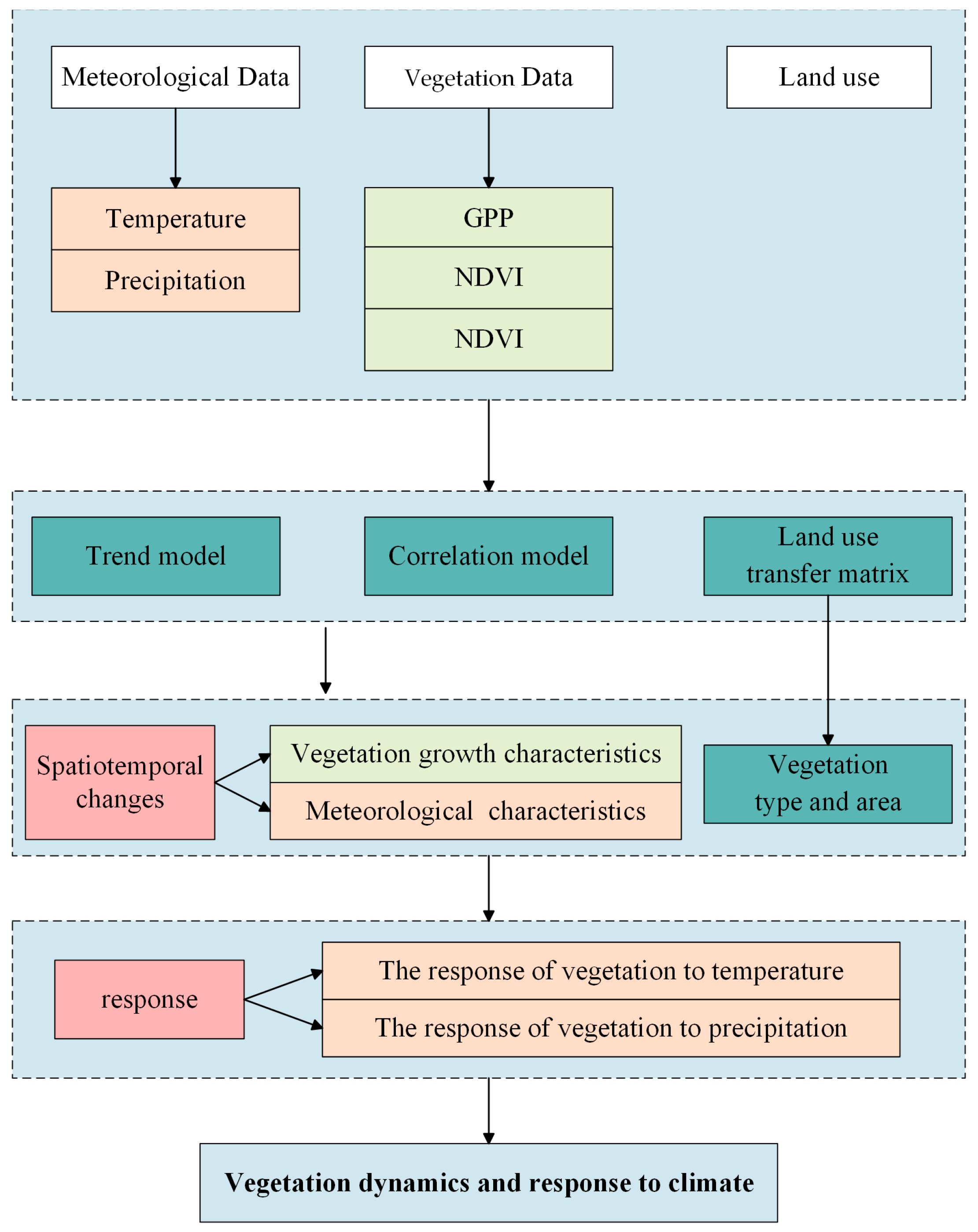
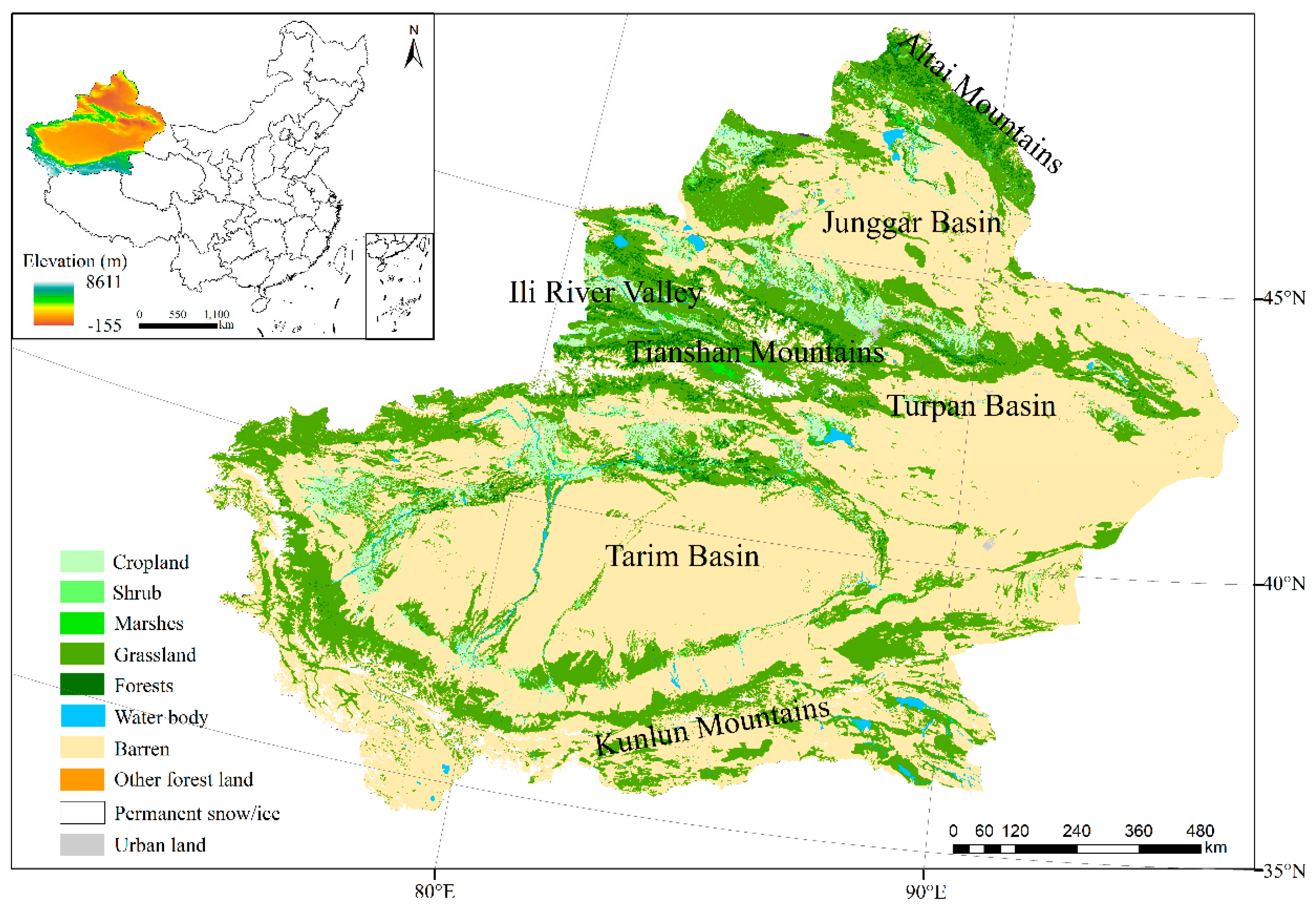
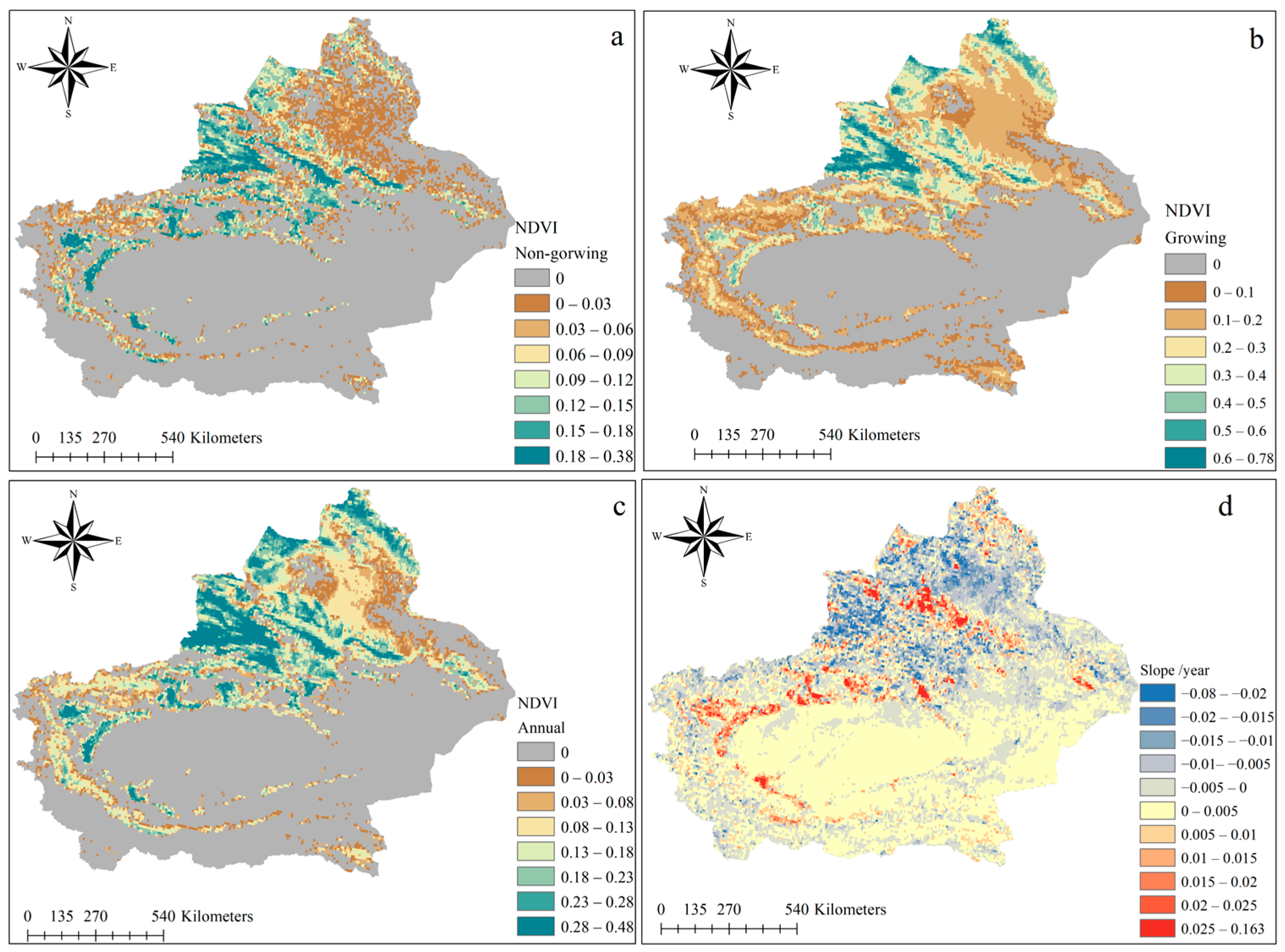
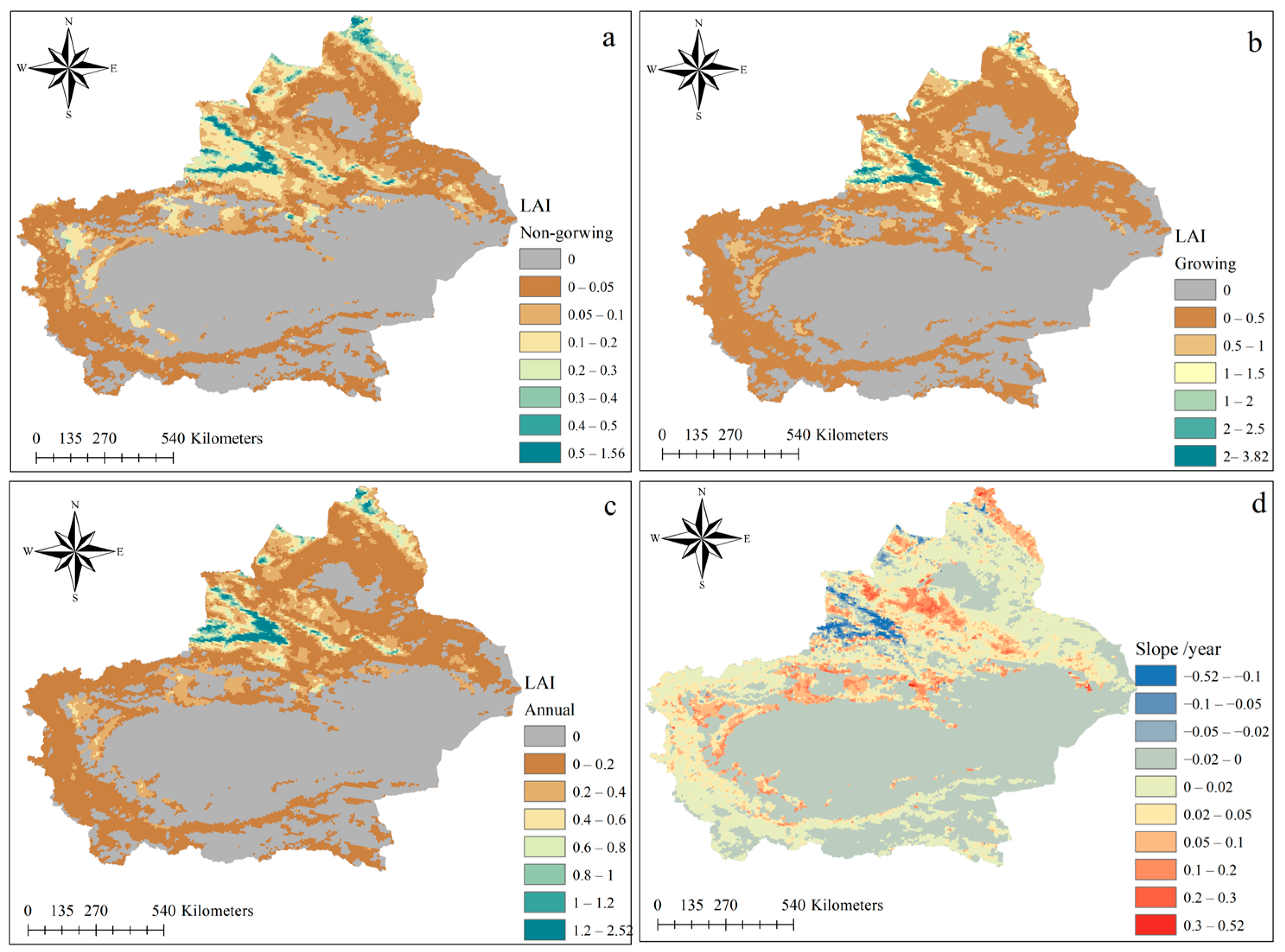

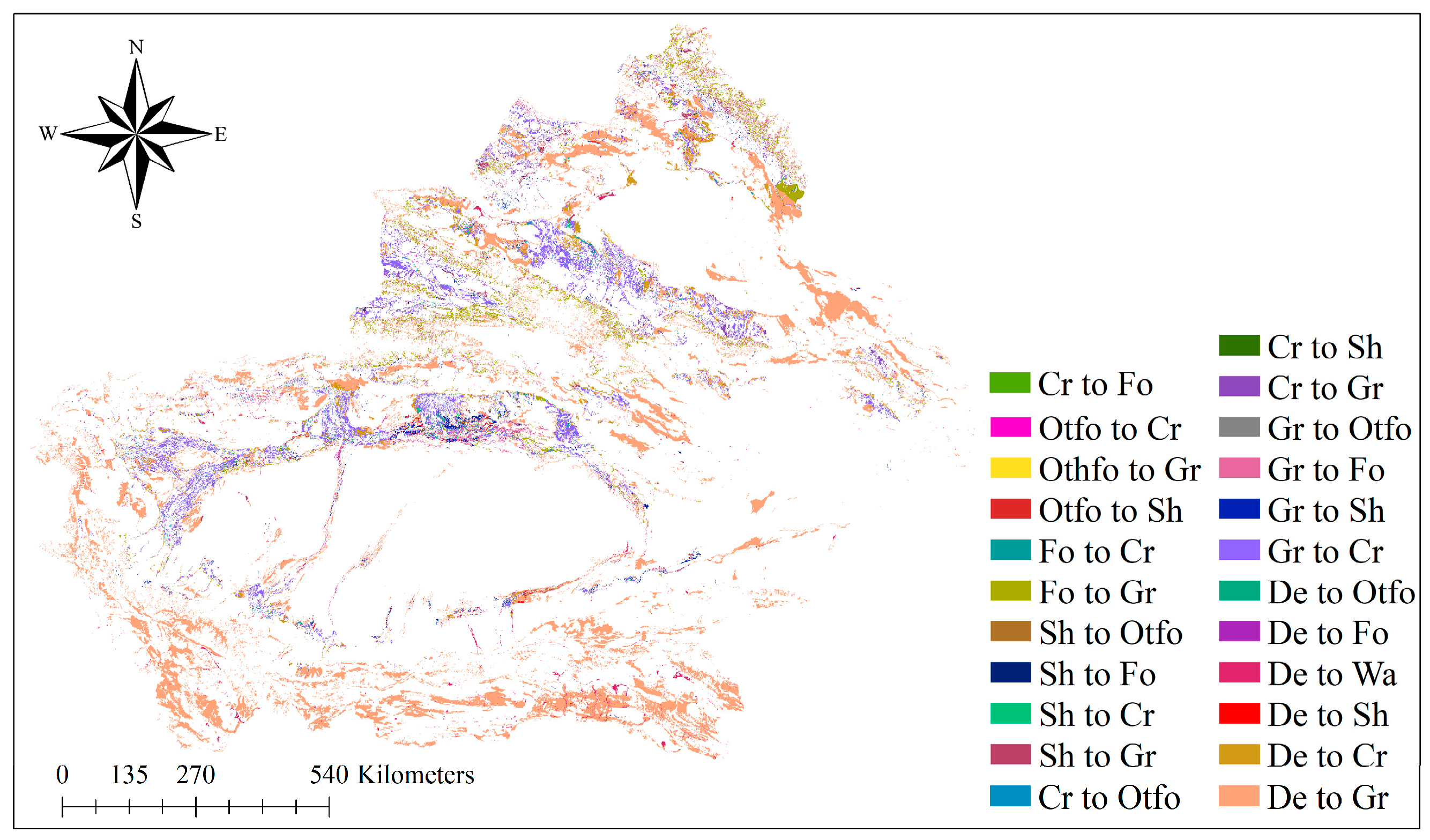
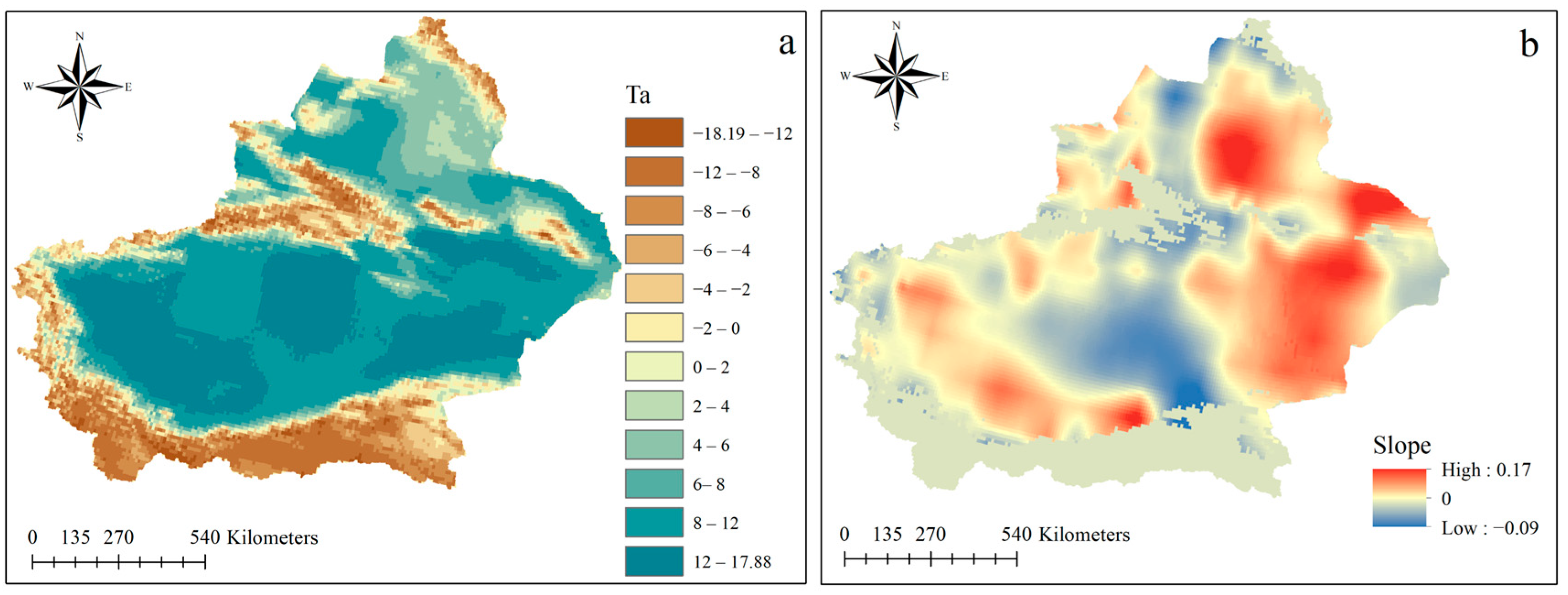


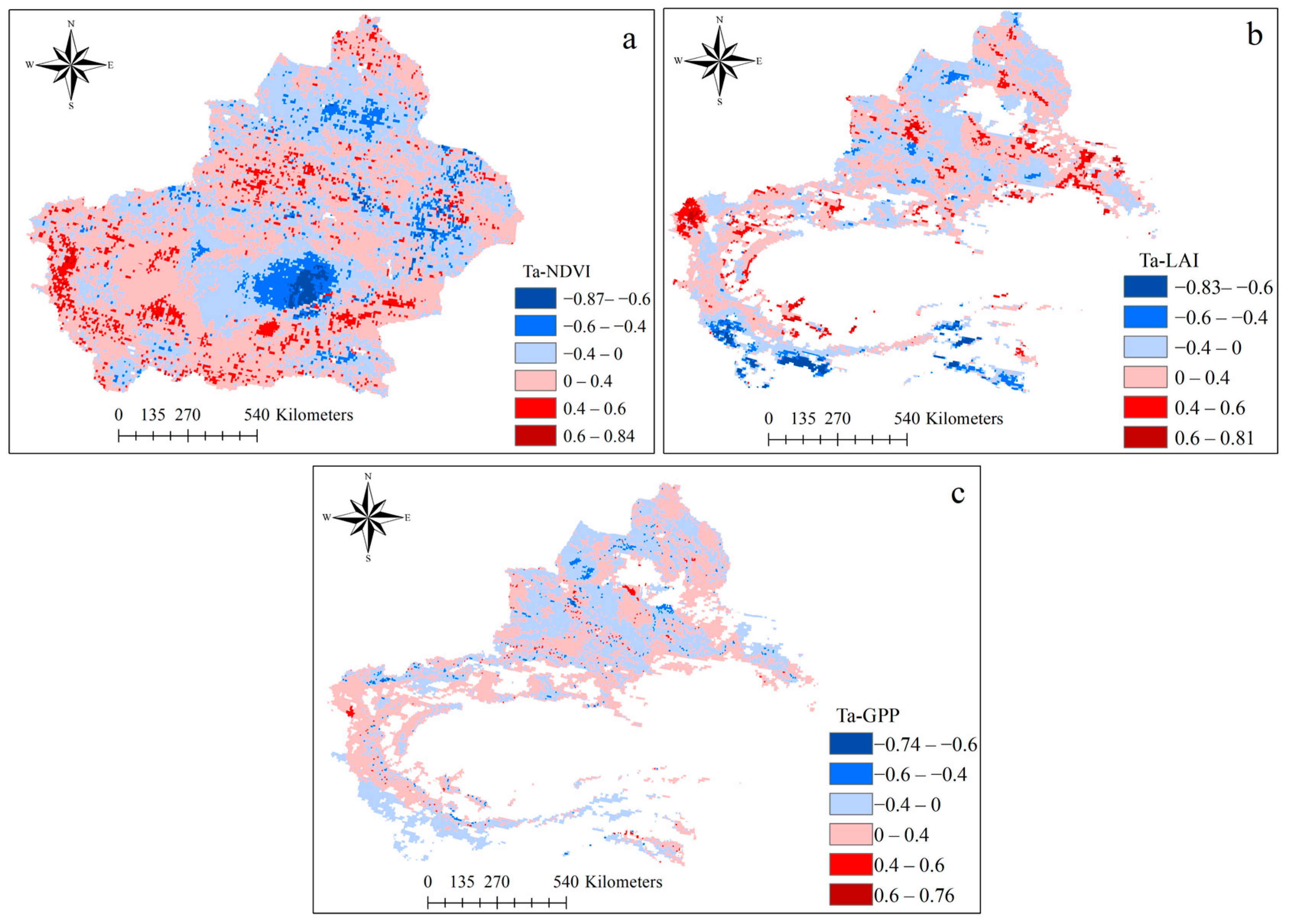
Disclaimer/Publisher’s Note: The statements, opinions and data contained in all publications are solely those of the individual author(s) and contributor(s) and not of MDPI and/or the editor(s). MDPI and/or the editor(s) disclaim responsibility for any injury to people or property resulting from any ideas, methods, instructions or products referred to in the content. |
© 2024 by the authors. Licensee MDPI, Basel, Switzerland. This article is an open access article distributed under the terms and conditions of the Creative Commons Attribution (CC BY) license (https://creativecommons.org/licenses/by/4.0/).
Share and Cite
Liu, Y.; Zhao, Y.; Wu, W.; Ao, X.; Chen, R. The Response of Vegetation Dynamics to Climate in Xinjiang from 1991 to 2018. Forests 2024, 15, 2065. https://doi.org/10.3390/f15122065
Liu Y, Zhao Y, Wu W, Ao X, Chen R. The Response of Vegetation Dynamics to Climate in Xinjiang from 1991 to 2018. Forests. 2024; 15(12):2065. https://doi.org/10.3390/f15122065
Chicago/Turabian StyleLiu, Yiwen, Yanni Zhao, Wentong Wu, Xinmao Ao, and Rensheng Chen. 2024. "The Response of Vegetation Dynamics to Climate in Xinjiang from 1991 to 2018" Forests 15, no. 12: 2065. https://doi.org/10.3390/f15122065
APA StyleLiu, Y., Zhao, Y., Wu, W., Ao, X., & Chen, R. (2024). The Response of Vegetation Dynamics to Climate in Xinjiang from 1991 to 2018. Forests, 15(12), 2065. https://doi.org/10.3390/f15122065




